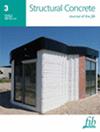通过灌浆套筒连接的预制混凝土剪力墙的平面外响应
IF 3.3
3区 工程技术
Q2 CONSTRUCTION & BUILDING TECHNOLOGY
引用次数: 0
摘要
预制(预制)混凝土剪力墙(PW)的平面外响应通常在结构设计中被忽略。然而,由于板的刚度相对较低且不可避免地会发生变形,因此剪力墙的平面外行为可能会影响平面内响应,造成过早破坏或稳定性问题,并影响整体结构性能。当采用单排连接时,由于中性轴向向压缩侧偏移,平面外承载力也会相应改变,因此这一问题变得非常重要。在这项研究中,我们在往复循环荷载下对带有灌浆钢套筒连接件的 PW 进行了测试。测试程序中既考虑了单排连接,也考虑了成对连接。结果表明,所有压水墙均因底部钢筋屈服而发生弯曲破坏,其承载能力和刚度退化趋势与整体(现浇)参考墙相似。在 0.12 的归一化压缩条件下,预制墙体的延性分别为 2.62 和 3.07,与现浇参考墙体的延性(2.72)相当。在不施加轴向压缩的情况下,单排连接的 PW 的滞后曲线表现出明显的挤压现象。尽管如此,由于轴向压缩较小,这些墙体的承载能力在试验结束时并未出现明显下降,表现出较高的变形能力。在两种荷载情况下,成对连接的 PW 比单排连接的试样表现出更高的能量耗散。本文章由计算机程序翻译,如有差异,请以英文原文为准。
Out‐of‐plane response of prefabricated concrete shear walls connected via grouted sleeves
The out‐of‐plane response of prefabricated (precast) concrete shear walls (PWs) are usually neglected in the structural designs. However, because of the relatively low stiffness and inevitable deformation of slabs, the out‐of‐plane behavior of PWs could influence the in‐plane response by causing premature failure or stability problems and affect the overall structural performance. This issue becomes significant when single‐row connections are employed because the neutral axial is shifted toward the compression side and the out‐of‐plane capacity is altered accordingly. In this study, PWs with grouted steel sleeve splices were tested under reciprocating cyclic loading. Both single‐row and paired connections were considered in test program. It was shown that all PWs suffered bending failure dominated by yielding of reinforcement at the bottom, and their load‐carrying capacity, stiffness degeneration trends were similar to the monolithic (cast‐in‐place) reference walls. Under the normalized compression of 0.12, the ductility of the prefabricated walls was 2.62 and 3.07, which was comparable to that of the reference cast‐in‐place wall (2.72). For the case that axial compression was not applied, the hysteresis curve of the PW with single‐row connection exhibited significant pinching. Nonetheless, the load‐carrying capacity of these walls did not exhibit significant drop at the end of the tests due to the lower axial compression, exhibiting high level of deformability. For both load cases, PWs with paired connection exhibited higher energy dissipation than the single‐row connected specimens.
求助全文
通过发布文献求助,成功后即可免费获取论文全文。
去求助
来源期刊

Structural Concrete
CONSTRUCTION & BUILDING TECHNOLOGY-ENGINEERING, CIVIL
CiteScore
5.60
自引率
15.60%
发文量
284
审稿时长
3 months
期刊介绍:
Structural Concrete, the official journal of the fib, provides conceptual and procedural guidance in the field of concrete construction, and features peer-reviewed papers, keynote research and industry news covering all aspects of the design, construction, performance in service and demolition of concrete structures.
Main topics:
design, construction, performance in service, conservation (assessment, maintenance, strengthening) and demolition of concrete structures
research about the behaviour of concrete structures
development of design methods
fib Model Code
sustainability of concrete structures.
 求助内容:
求助内容: 应助结果提醒方式:
应助结果提醒方式:


